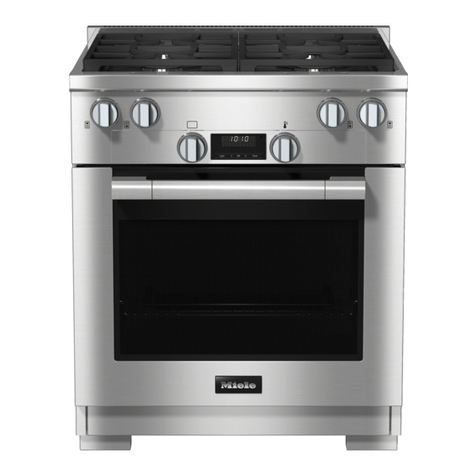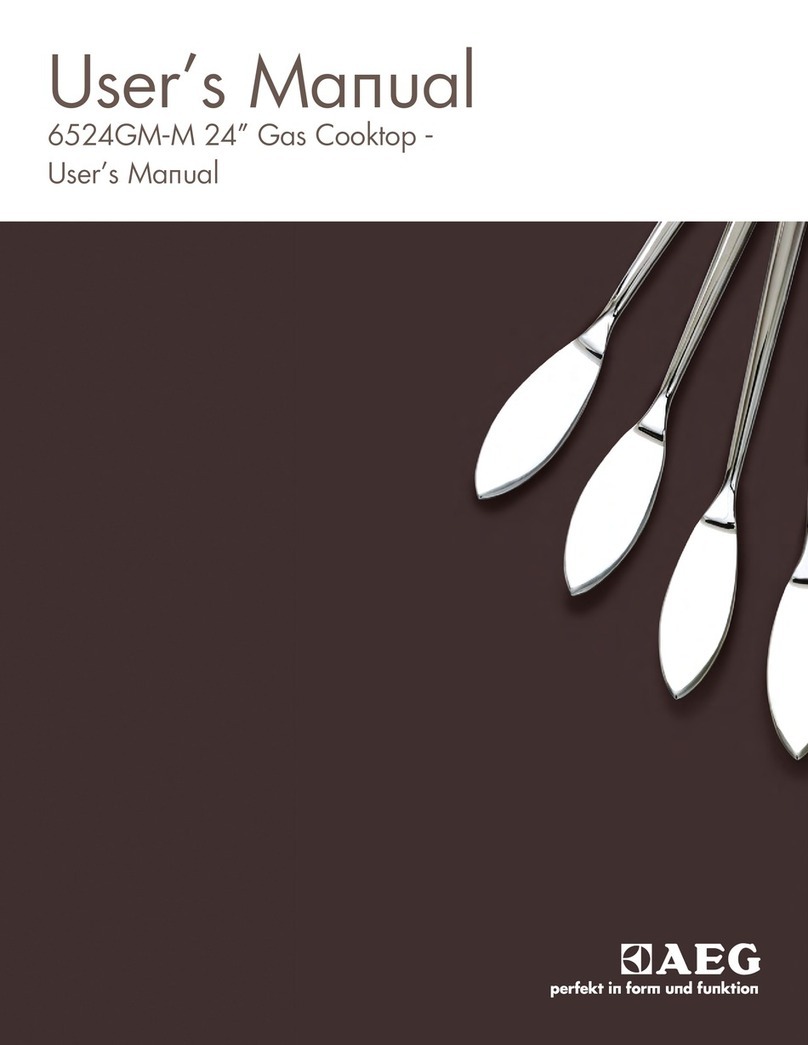
5
IMPORTANT - Please Read and Follow
Cooking Safety (cont.)
•NEVER wear garments made of flammable material or loose fitting or long-sleeved apparel while cooking. Clothing
may ignite or catch utensil handles. DO NOT drape towels or materials on oven door handles. These items could ignite
and cause burns.
•PREPARED FOOD WARNING: Follow food manufacturer’s instructions.If a plastic frozen food container and/or its cover
distorts, warps, or is otherwise damaged during cooking, immediately discard the food and its container. The food
could be contaminated.
•If you are “flaming” liquor or other spirits under an exhaust, TURN THE FAN OFF. The draft could cause the flames to
spread out of control.
•Once the unit has been installed as outlined in the Installation Instructions, it is important that the fresh air supply is
not obstructed. The use of a gas cooking appliance results in the production of heat and moisture in the room in which
it is installed. Ensure that the kitchen is well-ventilated. Keep natural ventilation holes open or install a mechanical
ventilation device (mechanical extractor hood). Prolonged or intensive use of the appliance may call for additional (such
as opening a window) or more effective ventilation (such as increasing the level of a mechanical ventilation if present).
Cookware Safety
•Use pans with flat bottoms and handles that are easily grasped and stay cool. Avoid using unstable, warped, easily
tipped or loose-handled pans. Also avoid using pans, especially small pans, with heavy handles as they could be
unstable and easily tip. Pans that are heavy to move when filled with food may also be hazardous.
•Be sure cookware is large enough to properly contain food and avoid boilovers. Pan size is particularly important in
deep fat frying. Be sure pan will accommodate the volume of food that is to be added as well as the bubble action of
fat.
•To minimize burns, ignition of flammable materials and spillage due to unintentional contact with the utensil, DO NOT
extend handles over adjacent surface burners. ALWAYS turn pan handles toward the side or back of the appliance, not
out into the room where they are easily hit or reached by small children.
•NEVER let a pan boil dry as this could damage the utensil and the appliance.
•Follow the manufacturer’s directions when using oven cooking bags.
•Only certain types of glass, glass/ceramic, ceramic or glazed cookware are suitable for cooktop surface without breaking
due to the sudden change in temperature. Follow manufacturer’s instructions when using glass.
•This appliance has been tested for safe performance using conventional cookware. DO NOT use any devices
or accessories that are not specifically recommended in this guide. DO NOT use eyelid covers for the surface
units, stovetop grills, or add-on oven convection systems. The use of devices or accessories that are not expressly
recommended in this manual can create serious safety hazards, result in performance problems, and reduce the life of
the components of the appliance.
•The flame of the burner should be adjusted to just cover the bottom of the pan or pot. Excessive burner setting may
cause scorching of adjacent counter-top surfaces, as well as the outside of the cookware. This is based on safety
considerations.
Cleaning Safety
•Turn off all controls and wait for appliance parts to cool before touching or cleaning them. DO NOT touch the burners
or surrounding areas until they have had sufficient time to cool.
•Clean appliance with caution. Use care to avoid steam burns if a wet sponge or cloth is used to wipe spills on a hot
surface. Some cleaners can produce noxious fumes if applied to a hot surface.
Important notice regarding pet birds:
NEVER keep pet birds in the kitchen or in rooms where the fumes from the kitchen could reach. Birds have a very
sensitive respiratory system. Fumes released due to overheated cooking oil, fat, margarine and overheated non-stick
cookware may be equally harmful.
WARNING
NEVER use appliance as a space heater to heat or
warm a room to prevent potential hazard to the user
and damage to the appliance. Also, DO NOT use the
cooktop as a storage area for food or cooking utensils.
CAUTION
DO NOT store items of interest to children over the unit. Children
climbing to reach items could be seriously injured.



















